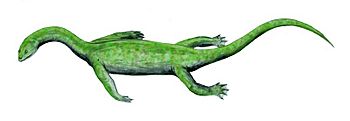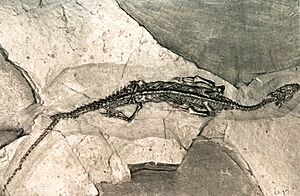Pachypleurosaurs facts for kids
Quick facts for kids Pachypleurosaurs |
|
|---|---|
 |
|
| Keichousaurus | |
| Scientific classification |
|
| Kingdom: | Animalia |
| Phylum: | Chordata |
| Class: | Reptilia |
| Superorder: | †Sauropterygia |
| Clade: | †Eosauropterygia |
| Suborder: | †Pachypleurosauria Nopcsa, 1928 |
| Genera | |
|
|
Pachypleurosaurs were a group of ancient reptiles that lived only during the Triassic period, which was a very long time ago. They looked a bit like lizards that lived in the water.
These creatures were long and slender, usually growing to be about 0.2 to 1 meter (about 8 inches to 3 feet) in length. They had small heads, long necks, and strong, deep tails that helped them swim. Instead of regular legs, they had paddle-like limbs, which were perfect for moving through water.
Scientists believe Pachypleurosaurs probably couldn't move very well on land. Their limb bones were quite small, suggesting they were mostly aquatic. They had widely spaced, peg-like teeth at the front of their jaws. This tells us they likely ate fish. One species, Prosantosaurus, was found to have eaten small fish and tiny crustaceans. It even had teeth that could grow back if they broke off! This was a special discovery, as it was the first time scientists saw tooth replacement in a European pachypleurosaur.
What are Pachypleurosaurs?
Pachypleurosaurs belong to a larger group of extinct marine reptiles called sauropterygians. These animals were well-adapted to life in the water. They were not dinosaurs, but rather a separate group of reptiles that lived around the same time.
How are Pachypleurosaurs Classified?
When scientists first studied Pachypleurosaurs, they often grouped them with another type of ancient marine reptile called nothosaurs. However, with newer ways of studying how animals are related (called cladistics), some scientists now think Pachypleurosaurs are a "sister group" to a larger group called Eosauropterygia. A sister group means they are very closely related and share a common ancestor.
The Eosauropterygia group includes both nothosaurs and the famous plesiosaurs. So, in simpler terms, Pachypleurosaurs are like close cousins to nothosaurs and plesiosaurs, sharing a family tree branch with them. Recent studies, like one from 2023 about Luopingosaurus, support this idea. They found Pachypleurosaurs are a sister group to Eusauropterygia, which contains both nothosaurs and another group called Pistosauroidea. This helps scientists understand the big family tree of ancient marine reptiles.
See also
 In Spanish: Pachypleurosauria para niños
In Spanish: Pachypleurosauria para niños


